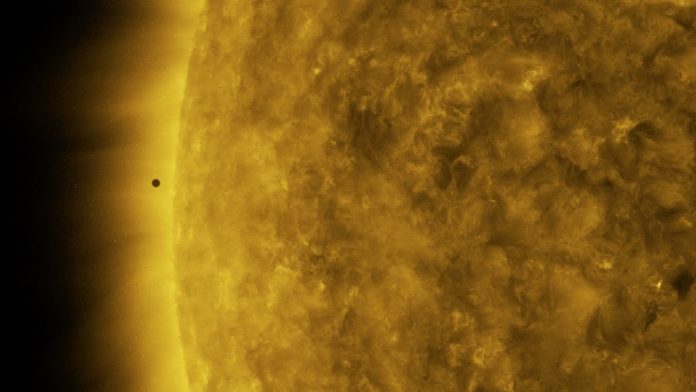Mercury underwent 13 transits during the entire century. In photos released by NASA, Mercury appears as a small black dot as it approaches the limb of the sun prior to its transit.
Mercury and Earth became perfectly aligned allowing stargazers to watch the planet at the front of the solar system pass along the face of the Sun. While the phenomenon was not visible to the naked eye, NASA satellites situated in Earth’s orbit captured the event in an ultraviolet video. Telescopes aboard the Solar Dynamics Observatory (SDO) recorded the phenomenon, showing a small black dot move its way across the massive ball of fire.
Website Space Weather said: “Millions of people on Earth witnessed the transit of Mercury on November 11th when the tiny black form of the first planet crossed the face of the sun. The best views were out of this world – literally.
“More than 22,000 miles above Earth’s surface, NASA’s SDO recorded an incredible movie of the transit.
“This movie is unlike any recorded on Earth. High above our planet’s atmosphere, extreme ultraviolet telescopes onboard SDO were able to see Mercury making first contact with the sun’s outer atmosphere, the corona.
“The wavelengths required to gain this view are blocked by air and only visible from space.”
Mercury in transit only happens on average 13 times a century, despite Mercury only taking 88 days to complete an orbit of the Sun.
The reason we rarely see the transit is due to the smallest planet in the solar system’s slightly wonky orbit.
The planet’s orbit has an incline of seven degrees, in relation to Earth’s orbital plane, so it is rare that Mercury and Earth are on the same level and side of the Sun as they cross our host star.
Royal Observatory Greenwich astronomer Tom Kerss said: “Although Mercury overtakes us several times per year on its relatively quick journey around the Sun, we don’t see transits every time, because Mercury’s orbit is quite highly inclined relative to that of the Earth.





























